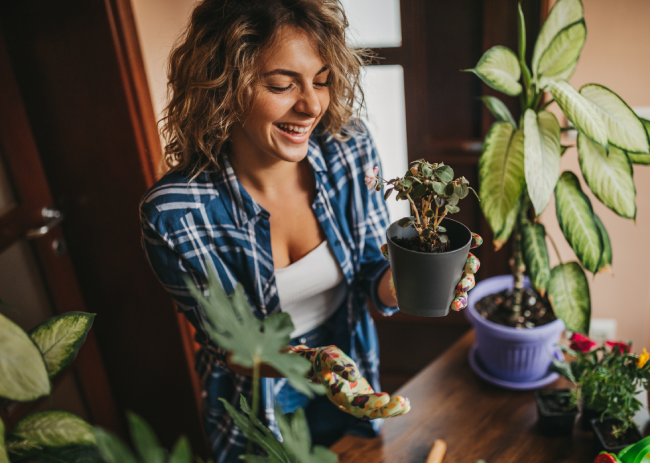Gardening is such a beautiful and satisfying hobby. There is nothing like watching a plant grow from a tiny sapling. Almost all of us love being surrounded by nature in one way or the other. Be it a big garden area in your backyard or a tiny money plant in the house. Starting a food garden or just an indoor plant place is a process in itself.
Therefore, gardening is not only good for health but also for the environment. This hobby in its own way helps relieve stress. Therefore, it really uplifts your mood after a tiresome day. As humans, we all have the urge to care for someone. We like to nurture and be nurtured. It is the same with plants too. Therefore, provide them with care and they nurture you back with freshness and produce. They not only purify the air around but also add a beautiful look to your house. We are always just one plant away to beautify a corner of the house.
Therefore, don’t hold back from growing your own produce. Start your own food garden!
What is a Food Garden?
A food garden is as it says: a garden through which we can make our own produce. This area is typically used to grow veggies and even some medicinal plants. Many people have started growing their own veggies at home. Instant access to fresh vegetables is very rewarding. You are practising your own farm-to-table concept. You save money on the vegetables you grow by yourself as well as your transport to go buy them.
Growing food at home isn’t a tough activity. It mostly requires passion and patience. You don’t need acres of land to create a food garden. Even a small space outside your house with enough sunlight works. In addition, there is some amount of investment required for seeds and supplies. Homegrown produce gives you complete control over chemical usage. Why would you want to spend on buying organic when you can make your own?
Which Fruits and Vegetables to Grow in Your Food Garden
Here are some of the easy-to-grow fruits and veggies:
- Bell Peppers: these are water-rich and require a good amount of sunlight to grow.
- Cabbage: This spring and fall crop grows well in a moist environment and cool temperature.
- Tomatoes: Tomatoes are usually grown in vegetable plots or large containers. In addition, they need deep soil and a good amount of sun.
- Spinach: Spinach is very easy to grow. It is a fast-growing plant and you get a lot of yields.
- Cucumber: This is an easy-to-grow fruit choice at home. The cucumber plant doesn’t require much attention. They can even be grown indoors!
- Potatoes: This vegetable is super easy to grow and has an amazing yield. They need less attention and effort. You could grow them on raised beds or containers. All they need is water, loose soil and a lot of sun.
- Garlic: Using cloves, you can sow these easy-growing plants. However, garlic takes a lot of time to grow.
- Coriander and Basil: Both these herbs are often used while cooking and can germinate within a week’s time.
7 Easy Steps to Start a Food Garden
Here are seven easy steps you can use to set up a food garden at your home:
- Rich Soil: Having rich soil for your plant in many ways. It is important for its healthy growth and nutrition. In addition, it is important for the filtration of water too.
- Seedlings: Grow your seedlings in a tray before planting them. This ensures better nutrition for seeds as well as easy planting.
- Seasonal: It is important to grow veggies and fruits based on the season they can best tolerate.
- Organic: Always use organic fertilisers instead of chemicals. These fertilisers are made using natural sources. Therefore, manure, compost, and vermicompost are generally used.
- Food Scraps: Kitchen scraps can be separated using a three-bin system. They help hold moisture in your soil. They improve soil nutrition and health.
- Water: Water is necessary for almost any plant. Therefore, it is important to ensure watering your plant daily as per its requirement. If you are unable to do so, use a drip system.
- Position: Know your plant. Know how much sunlight a plant needs. You should know whether to place it in how much shade or light.
FAQs:
What Is The Easiest Food To Grow In A Garden?
Salad leaves! Salad leaves are among the easiest and quickest growing crops. They don’t need a big space. You can grow them in pots or growing bags. Your salad greens could range from lettuce to spinach Generally salad greens grow well in a cool environment. Most home gardeners grow their own salad leaves.
What Is The Easiest Way To Start A Garden?
Grow only what and how much you will consume and begin with the easiest crops to grow. Start with 2 plants and then keep moving ahead yearly as you see improvement. Ensure having good fertile soil and enough water supply.
How Do You Start A Simple Vegetable Garden?
To start your garden, it is necessary that you first find the right location. Your garden spot must be able to receive at least 6-8 hours of sunlight. Always begin small, don’t start a big garden right away. Plan your garden well.
How Do You Start A Garden At Home For Beginners?
As a beginner, your first priority must be choosing the right seeds and veggies to plant. Invest in buying the basic garden tools. Begin small and with easy plants. Nurture your garden daily. You will realise how soothing this entire activity is. Once you keep all these small things in mind, you can begin your easy food garden.
What’s The Quickest Vegetable To Grow?
Your salad leaves are the quickest veggies to grow! There are a lot of varieties in salad leaves. Kale, arugula and lettuce are some of the famous varieties. Usually, the time from sow to harvest for salad leaves is about 20 days. Cress is another plant which is mostly used in salads. These plants are ready to harvest within a week’s time.
In Conclusion
Watching your garden grow from mere soil to greens is so satisfying. Gardening as an activity has proven to show mental health benefits! Finally, growing your own produce is something everyone must start doing.
We live in a world with depleting resources and an overwhelming population. We must ensure that we are capable of creating our own food instead of heavily depending on others. Doing so also gives us the freedom to recycle food waste and use organic fertilisers. It helps you reduce your environmental footprint.
You will be able to easily realise the difference in taste between homegrown and store-bought produce. It is superior in taste and quality. That is the beauty of having your own food garden.
This infographic visually explores how to start a food garden at home.
Paridhi Maheshwari is a content writer at F and B Recipes and Snazzy Women. She’s an aspiring journalist aiming to cover human interest stories through the power of her words.

